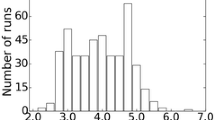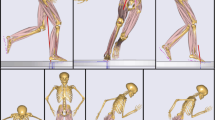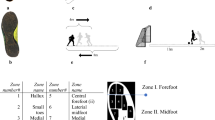Abstract
Due to its capabilities in analysing injury risk, the ability to analyse an athlete’s ground reaction force and joint moments is of high interest in sports biomechanics. However, using force plates for the kinetic measurements influences the athlete’s performance. Therefore, this study aims to use a feed-forward neural network to predict hip, knee and ankle joint moments as well as the ground reaction force from kinematic data during the execution and depart contact of a maximum effort 90° cutting manoeuvre. A total number of 525 cutting manoeuvres performed by 55 athletes were used to train and test neural networks. Either marker trajectories or joint angles were used as input data. The correlation coefficient between the measured and predicted data indicated strong correlations. By using joint angles as the input parameters, slightly but not significantly higher accuracy was found in joint moments predictions. The prediction of the ground reaction force showed significantly higher accuracy when using marker trajectories. Hence, the proposed feed-forward neural network method can be used to predict motion kinetics during a fast change of direction. This may allow for the simplification of cutting manoeuvres experimental set-ups for and through the use of inertial sensors.

The left part of the graphical abstract displays the angle progression of the hip, knee and ankle joint as an example of the kinematic input data and is supported by a stick figure of the motion task, a 90° cutting manoeuvre. This data is used to train a feed-forward neural network, which is displayed in the middle. The neural network’s output is displayed on the right. As an example of the kinetic data, the joint moments of hip, knee and ankle joint are displayed and supported by a stick figure.






Similar content being viewed by others
References
Ardestani MM, Zhang X, Wang L, Lian Q, Liu Y, He J, Li D, Jin Z (2014) Human lower extremity joint moment prediction: a wavelet neural network approach. Expert Syst Appl 41(9):4422–4433. https://doi.org/10.1016/j.eswa.2013.11.003
Bezodis NE, Salo AIT, Trewartha G (2013) Excessive fluctuations in knee joint moments during early stance in sprinting are caused by digital filtering procedures. Gait Posture 38(4):653–657. https://doi.org/10.1016/j.gaitpost.2013.02.015
David S, Komnik I, Peters M, Funken J, Potthast W (2017) Identification and risk estimation of movement strategies during cutting maneuvers. J Sci Med Sport 20(12):1075–1080. https://doi.org/10.1016/j.jsams.2017.05.011
David S, Mundt M, Komnik I, Potthast W (2018) Understanding cutting maneuvers – the mechanical consequence of preparatory strategies and foot strike pattern. Hum Mov Sci 62:202–210. https://doi.org/10.1016/j.humov.2018.10.005
Elliott B, Alderson JA (2007) Laboratory versus field testing in cricket bowling: a review of current and past practice in modelling techniques. Sports Biomechanics 6(1):99–108. https://doi.org/10.1080/14763140601058623
Favre J, Jolles BM, Aissaoui R, Aminian K (2008) Ambulatory measurement of 3D knee joint angle. J Biomech 41(5):1029–1035. https://doi.org/10.1016/j.jbiomech.2007.12.003
Halilaj E, Rajagopal A, Fiterau M, Hicks JL, Hastie TJ, Delp SL (2018) Machine learning in human movement biomechanics: best practices, com-Mon pitfalls, and new opportunities machine learning in human movement biomechanics: best practices, common pitfalls, and new opportunities. J Biomech. https://doi.org/10.1016/j.jbiomech.2018.09.009
Jie-han Ngoh K, Gouwanda D, Gopalai AA, Yu C (2018) Estimation of vertical ground reaction force during running using neural network model and uniaxial accelerometer. J Biomech 76:269–273. https://doi.org/10.1016/j.jbiomech.2018.06.006
Johnson WR, Donnelly CJ, Mian AS, Alderson JA (2017) Prediction of ground reaction forces and moments via supervised learning is independent of participant sex, height and mass. Isbs 2017:1–4
Johnson WR, Mian A, Donnelly CJ, Lloyd D, Alderson J (2018) Predicting athlete ground reaction forces and moments from motion capture. Med Biol Eng Comput 56(10):1781–1792. https://doi.org/10.1007/s11517-018-1802-7
Kristianslund E, Krosshaug T, Van den Bogert AJ (2012) Effect of low pass filtering on joint moments from inverse dynamics: implications for injury prevention. J Biomech 45(4):666–671. https://doi.org/10.1016/j.jbiomech.2011.12.011
Lee MJC, Lloyd DG, Lay BS, Bourke PD, Alderson JA (2013) Effects of different visual stimuli on postures and knee moments during sidestepping. Med Sci Sports Exerc 45(9):1740–1748. https://doi.org/10.1249/MSS.0b013e318290c28a
Liu Y, Shih S-M, Tian S-L, Zhong Y-J, Li L (2009) Lower extremity joint torque predicted by using artificial neural network during vertical jump. J Biomech 42(7):906–911. https://doi.org/10.1016/j.jbiomech.2009.01.033
Lund ME, Andersen MS, de Zee M, Rasmussen J (2015) Scaling of musculoskeletal models from static and dynamic trials. Int Biomech 2(1):1–11. https://doi.org/10.1080/23335432.2014.993706
Oh SE, Choi A, Mun JH (2013) Prediction of ground reaction forces during gait based on kinematics and a neural network model. J Biomech 46(14):2372–2380. https://doi.org/10.1016/j.jbiomech.2013.07.036
Osateerakun P, Barton G, Foster R, Bennett S, Lakshminarayan R (2018) P 037 – prediction of moments from movements without force platforms using artificial neural networks: a pilot test. Gait Posture 65(xxxx):299–300. https://doi.org/10.1016/j.gaitpost.2018.06.194
Richter C, King E, Falvey E, Franklyn-Miller A (2018) Supervised learning techniques and their ability to classify a change of direction task strategy using kinematic and kinetic features. J Biomech 66:1–9. https://doi.org/10.1016/j.jbiomech.2017.10.025
Robert-Lachaine X, Mecheri H, Larue C, Plamondon A (2016) Validation of inertial measurement units with an optoelectronic system for whole-body motion analysis. Med Biol Eng Comput 55(4):609–619. https://doi.org/10.1007/s11517-016-1537-2
Sivakumar S, Gopalai AA, Gouwanda D, Hann LK (2016) ANN for gait estimations: a review on current trends and future applications. IEEE EMBS Conference on Biomedical Engineering and Science (IECBES), pp 311–316
Wouda FJ, Giuberti M, Bellusci G, Maartens E, Reenalda J, van Beijnum B-JF, Veltink PH (2018) Estimation of vertical ground reaction forces and sagittal knee kinematics during running using three inertial sensors. Front Physiol 9:1–14. https://doi.org/10.3389/fphys.2018.00218
Acknowledgements
We thank Adrian Vincent for proofreading this manuscript.
Funding
There was no external financial support of this project.
Author information
Authors and Affiliations
Corresponding author
Ethics declarations
Conflict of interest
The authors declare that they have no conflict of interest.
Ethical approval
All procedures performed in this study involving human participants were in accordance with the ethical standards of the Ethical Committee of the German Sport University Cologne and with the 1964 Helsinki declaration and its later amendments or comparable ethical standards.
Additional information
Publisher’s note
Springer Nature remains neutral with regard to jurisdictional claims in published maps and institutional affiliations.
Rights and permissions
About this article
Cite this article
Mundt, M., David, S., Koeppe, A. et al. Intelligent prediction of kinetic parameters during cutting manoeuvres. Med Biol Eng Comput 57, 1833–1841 (2019). https://doi.org/10.1007/s11517-019-02000-2
Received:
Accepted:
Published:
Issue Date:
DOI: https://doi.org/10.1007/s11517-019-02000-2




